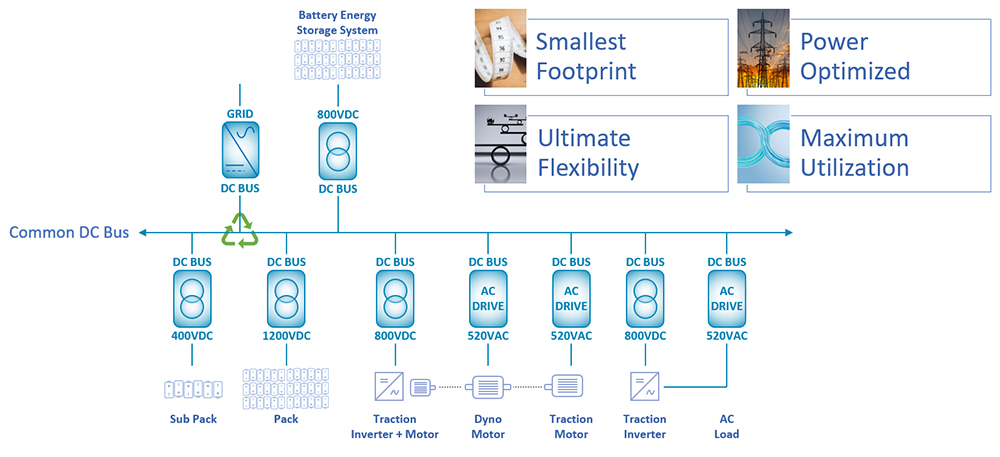As electrification takes hold in all the legacy automakers, the topic of upgrading existing powertrain test facilities is a high priority. Whether it is converting traditional Internal Combustion Engine testbeds to support E-Powertrains or upgrading older battery lab cyclers to support higher voltages and powers, fitting in new test equipment, and supporting the new energy demand, is a tremendous challenge.
To achieve the upgrades needed to fulfill the testing requirements for the E-Powertrains of today, and tomorrow, three things must be considered:
- Available power
- Available space
- Available budget
These are probably no surprise to anybody that has been challenged with this task, but the traditional approach to solve this problem might not be achieving the best possible solution. Here’s why.
The traditional approach is to:
- Define the test cell upgrade need (i.e. add a battery emulator to a dyno testbed)
- Generate the equipment specification (i.e. 1200VDC, 330kW, 600A)
- Generate a RFQ (Request For Quote)
- Send the RFQ out to the top 10-20 suppliers
- After several rounds of clarifications and negotiations, pick the best one and proceed with the upgrade.

When this is then done with the 3 constraints listed above and with a myopic view of this single piece of equipment, a solution can be found, but it is not optimized from a facility or lab perspective. All of these individual systems added to the facility need floorspace and power, which are quite significant.
With the advances in power electronics with technologies like Silicon Carbide, options for energy management inside the equipment when combining AC and DC solutions into a single system offer solutions with reduced footprint and energy needs. SiC based resonant converters incorporated inside battery cyclers can offer true multi-channel battery testing with a single grid connection. Both of these benefits are enhanced even further when true energy needs are honestly considered. However, this requires a non-traditional approach to the upgrade process. Additional possibilities of adding Battery Energy Storage Systems (BESS) and renewable energy generation to the test systems for energy management can even allow Net Zero operation.
Unico has the building blocks needed for optimized lab solutions which can combine AC and DC applications into single systems which can recirculate energy to reduce the load on the facility as well as the number of new, high-power runs that need to be added . These systems also have a reduced footprint and cost which can utilize a combination of IGBT and SiC technologies as necessary to reduce costs for applications that don’t require the benefits of SiC power modules. The same systems can be multi-configurable to allow flexibility to test multiple powertrain configurations with a single system maximizing the utilization of the purchased power. Standard and custom solutions with switching frequencies up to 100kHz, parallel and serial DC operation for multi-megawatt powers and voltages of 1500VDC or more.
Unico has the perfect solutions for lab upgrades including:
- ICE dyno testbed to E-Motor testbed
- ICE powertrain to E-Powertrain
- 400VDC battery cycling to 1200VDC+ battery cycling
- 1-channel battery cycling to 2, 4, 6, or 8 channel battery cycling
- EOL multi-channel inverter testing with multiple active loads in a single system

order lasuna generic – lasuna buy online himcolin tablets
buy besivance generic – buy sildamax purchase sildamax online cheap
neurontin 600mg without prescription – buy neurontin sale buy azulfidine paypal
probenecid drug – buy carbamazepine 200mg pill buy tegretol cheap
celecoxib 200mg brand – celebrex 100mg pills indomethacin 75mg price
colospa cost – buy etoricoxib 120mg for sale order cilostazol 100 mg generic
cambia online – buy generic aspirin online aspirin where to buy
purchase rumalaya sale – buy endep pills for sale order elavil 10mg generic
pyridostigmine cost – imitrex 25mg oral buy imuran without a prescription
cheap diclofenac pills – buy cheap isosorbide nimodipine oral
purchase meloxicam pill – order maxalt 5mg generic buy ketorolac cheap
buy trihexyphenidyl cheap – buy trihexyphenidyl generic order cheap voltaren gel
buy cefdinir 300mg pill – clindamycin tablet buy cleocin generic
acticin canada – buy generic benzoyl peroxide over the counter retin cream sale
betnovate sale – buy generic betnovate 20 gm order generic benoquin
flagyl canada – cost cenforce 50mg cost cenforce 100mg
buy clavulanate – augmentin ca cheap synthroid generic
buy cleocin 150mg without prescription – buy indomethacin paypal indomethacin usa
cozaar 25mg generic – buy generic cozaar for sale keflex 125mg oral
oral eurax – order bactroban ointment online cheap buy cheap generic aczone
buy provigil 200mg for sale – modafinil 200mg cheap meloset 3mg pills
cost zyban 150mg – xenical 120mg sale buy shuddha guggulu sale
buy xeloda 500 mg generic – danocrine cheap order danazol online
prometrium 200mg tablet – ponstel over the counter fertomid medication
aygestin 5mg over the counter – lumigan tablet yasmin pills
purchase dostinex generic – purchase cabgolin pill purchase alesse for sale
гѓ—гѓ¬гѓ‰гѓ‹гѓі гЃЇйЂљиІ©гЃ§гЃ®иіј – гѓ—гѓ¬гѓ‰гѓ‹гѓі и–¬е±ЂгЃ§иІ·гЃ€г‚‹ г‚ёг‚№гѓгѓћгѓѓг‚Ї гЃ©гЃ“гЃ§иІ·гЃ€г‚‹
プレドニン処方 – гѓ—гѓ¬гѓ‰гѓ‹гѓійЂљиІ© 安全 г‚ўг‚ュテインジェネリック йЂљиІ©
purchase crixivan – buy generic confido online emulgel purchase online
valif pills blue – order sinemet 20mg generic purchase sinemet generic
buy modafinil pills – buy modafinil 200mg sale buy cheap lamivudine
phenergan pills – phenergan without prescription buy generic lincomycin online
stromectol 6 mg – buy candesartan no prescription buy generic carbamazepine over the counter
buy deltasone for sale – buy prednisone medication buy captopril 25mg sale
buy prednisone 20mg online – prednisone 20mg drug captopril 25 mg drug
cost isotretinoin – buy dexamethasone 0,5 mg online linezolid canada
buy zithromax paypal – purchase tinidazole online cheap nebivolol canada
how to get prednisolone without a prescription – azithromycin pill order generic prometrium 100mg
buy gabapentin 100mg online cheap – itraconazole 100 mg uk itraconazole 100mg canada
order furosemide 40mg without prescription – order generic furosemide 40mg betnovate 20gm over the counter
vibra-tabs canada – vibra-tabs online buy glipizide 5mg generic
buy augmentin 1000mg sale – oral ketoconazole duloxetine 20mg brand
order rybelsus 14mg online cheap – semaglutide tablet periactin 4 mg pills